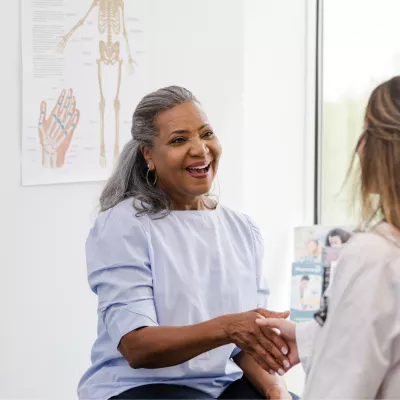- AdventHealth

While one in every 10 women between the ages of 15 and 44 experience endometriosis — a condition that can significantly affect quality of life and even fertility — most don’t realize that severe pain during their periods isn’t normal or that there are treatments to help.
For many women, the path to finding effective relief is met with great challenges. But thanks to our network of women's care expertise, there is help and hope for women that suffer from this disease.
Endometriosis Explained
Endometriosis is a condition that occurs when the lining of the uterus (called the endometrium) grows outside of the uterus. Endometrial tissues may grow in the fallopian tubes, around the ovaries, or in other areas of the abdomen.
Even though the endometrial tissue grows outside the uterus, it acts just like it would while in the uterus. During your menstrual cycle, the tissue gets thick, then sheds and bleeds. Since there is nowhere for the blood and lining to go, it stays in your body irritating the cells around it. The irritated cells can form scar tissue and adhesions that cause your pelvic organs to stick together.
You’re Not Alone
Although highly common, symptoms remain underreported and early diagnosis is quite difficult.
Recently, it has been suggested that it can take up to a decade to diagnose and treat this disease once symptoms begin.
Multiple touchpoints are noted to occur once the patient finally complains about pain with menses (the menstrual cycle or monthly bleeding), pelvic pain that can occur any time throughout the month, or dyspareunia (pain with intercourse).
A Disease with Great Impact
Endometriosis flares up dramatically during the prime reproductive years. Not only does it strongly impact quality of life but the disease's effects can trickle down to lifestyle choices, fertility and interpersonal relationships.
Furthermore, endometriosis is associated with absenteeism. The average woman with pelvic pain misses six to 10 hours of work per week. And of those that do go to work, many are suffering which leads to “presenteeism” in that their quality of work and ability to work is diminished.
With such a significant impact, endometriosis is a serious concern and currently, it is not being treated with the same intensity as other chronic and debilitating diseases like diabetes and hypertension.
Symptoms of Endometriosis
Endometriosis can be very painful and worsen during your menstrual cycle. The pain may even get worse over time, with every period you have. You may also experience other symptoms, such as:
- Bloating
- Constipation or diarrhea
- Fatigue
- Heavy bleeding during periods
- Infertility
- Pain when you use the bathroom
If you have heavy, painful periods, it’s important to talk with your doctor about the possibility of endometriosis since early detection may help you achieve better outcomes. Due to the variety in diagnosis timelines, it's encouraged to bring it up as early as possible in order to halt the disease in its tracks before it runs rampant.
Risks for Endometriosis
While the cause of endometriosis isn’t clear, doctors have identified several factors that may put you at higher risk for the condition. You may be at risk for endometriosis if you have:
- Menstrual cycles of 27 days or less
- A mother or sister with the condition
- Low body mass index
- Never given birth
- Started menstruating before age 10
- Uterine abnormalities
Endometriosis typically develops several years after you start menstruating. And even if you have a few of these risk factors, you still may never develop the condition.
How Doctors Diagnose Endometriosis
If you have symptoms of endometriosis, your doctor may order a diagnostic test like an ultrasound or magnetic resonance imaging (MRI) to look for signs of endometriosis in your pelvis.
Sometimes, endometriosis is diagnosed through laparoscopy, a minimally invasive surgical procedure. During a laparoscopy, a doctor makes a small incision near your belly button and inserts a small, flexible camera that takes images of your tissues for a more accurate diagnosis.
Effective Treatments for Endometriosis
Medical Therapy
Until recently, there have not been any FDA-approved medications to treat the disease, and many physicians have no clear-cut treatment pathway that has been proven to help patients.
Drugs like oral contraceptives that contain estrogens, NSAIDS like Advil or Motrin, opioids like Tylenol with codeine, Percocet, Vicodin, high dose progesterone and IUDS all have been tried in the treatment of endometriosis, but many are not FDA-approved or effective. Certain medical therapy treatments with a gonadotrophin-releasing hormone (GnRH) agonist has been approved by the FDA to reduce moderate to severe pain associated with endometriosis with relative success.
Surgery
Some physicians believe surgery should be a last treatment with medical therapies being tried initially, several of AdventHealth's team of women's care experts included. This standpoint doesn't limit our care team from delivering excellent results for those patients that do require surgery. With state-of-the-art surgical suites and technology, our physicians use minimally invasive techniques while offering better outcomes for the patient in reducing long-term pain.
Trust an Expert Team
For any woman suffering with pelvic pain in silence: your voice (and treatment options) will be heard here.
If you have endometriosis, if you’ve been struggling to find an expert who can help you — you’ll find answers here.
Start Feeling Your Best Again
You can find all the care you need for endometriosis at AdventHealth. We’re here to help you live your best life with advanced treatments and whole-person care. Learn more about our women's care here.



